The Dell Latitude 7455 is a compact, lightweight laptop built for professionals who need a balance of performance, portability, and connectivity. Its aluminum design combines durability with sustainability, while its 14-inch QHD+ display is optimized for long work sessions. With fast charging, strong battery life, and advanced wireless options like Wi-Fi 7 and 5G, the Latitude 7455 is designed for on-the-go professionals who require reliable, consistent performance wherever they work. Let’s dive into the details to see what this laptop offers.
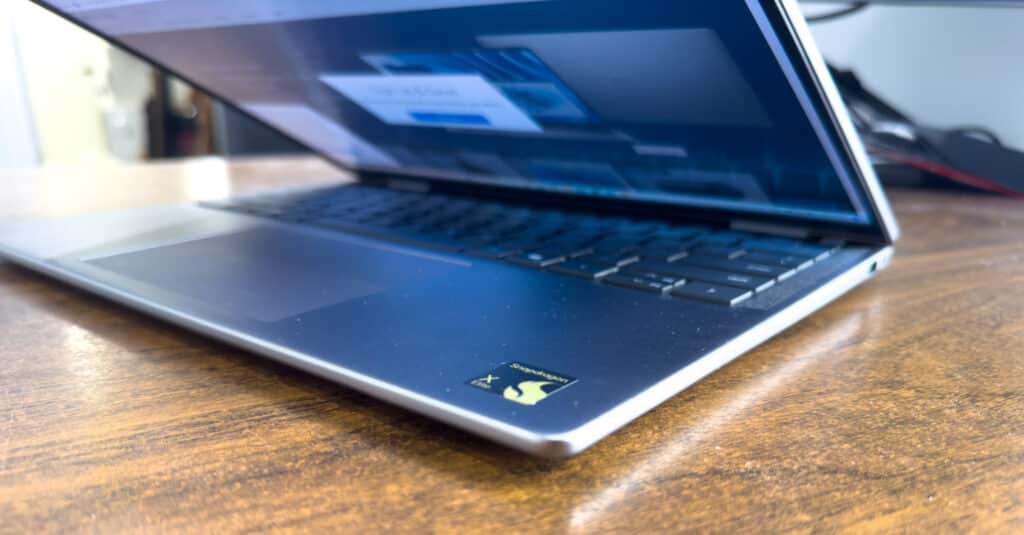
Dell Latitude 7455 and the Snapdragon X Elite CPU
The Snapdragon X Elite line is built for professionals who need reliable performance without sacrificing efficiency. Our build uses the X1E-80-100 model, with 12 cores and a boost clock of up to 4.0 GHz. This makes it well-suited for multitasking, running intensive productivity tasks, and managing AI-enhanced applications. It’s an excellent choice for users who need to manage complex workflows, whether juggling multiple apps or relying on tools like Microsoft Copilot to automate tasks and boost productivity.
Its Neural Processing Unit highlights the Snapdragon X Elite processor(NPU), delivering 45 TOPS of AI computing power. This allows for real-time noise cancellation during video calls, improved voice recognition, and faster AI-based image editing. If you’re in a field where AI tools play a significant role—like video conferencing, data analysis, or creative software that uses AI—this processor dramatically improves the experience. It handles these tasks without putting too much strain on the CPU or GPU, contributing to longer battery life.
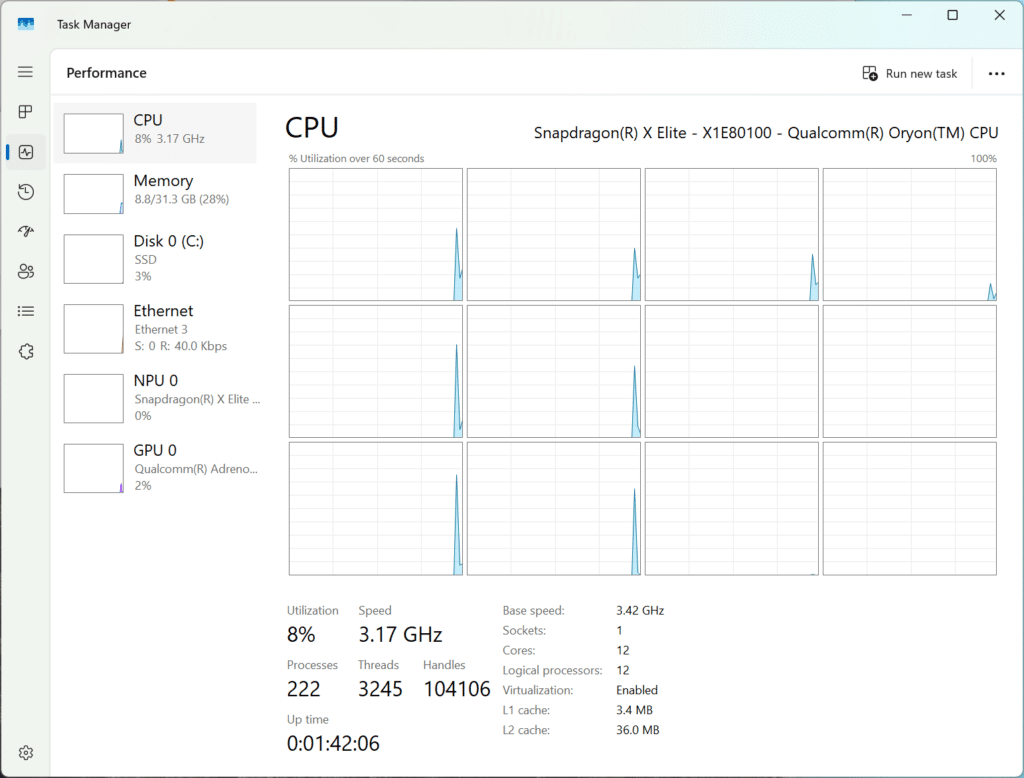
However, there are some limitations. While the Snapdragon X Elite is excellent for business users and professionals who need a solid balance of power and battery efficiency, it’s not the best fit for those requiring intense computing power, such as 3D rendering, heavy video editing, or gaming that demands a high-end GPU. It can handle light gaming or media consumption but isn’t designed for more resource-intensive games or software that relies on AVX/AVX2 instructions, better supported by Intel or AMD processors.
In comparison, the Snapdragon X1P-64-100, available in other configurations of the Latitude 7455, has ten cores and maxes out at 3.4 GHz. This model focuses more on power efficiency, making it suitable for users who prioritize longer battery life over peak performance. It’s great for standard tasks like web browsing, video calls, and document management, but it doesn’t offer the same performance headroom as the X1E-80-100 for more demanding workloads.
Dell Latitude 7455 Features and Components
The Dell Latitude 7455 features a 14.0-inch QHD+ (2560×1600) IPS touchscreen that delivers vibrant visuals (more information below), making it ideal for productivity tasks, media consumption, and light creative work. The anti-glare (AG) coating helps reduce reflections, ensuring better visibility in various lighting conditions, while ComfortView+ technology reduces blue light emissions to ease eye strain during long work sessions. The screen also offers a respectable brightness level of 400 nits, making it usable in most outdoor settings.
The Dell Latitude 7455 offers a few memory and storage configurations. You can choose between 16 GB or 32 GB of LPDDR5x memory for RAM, running at 8448 MT/s. Since the RAM is onboard, it cannot be upgraded, so selecting the suitable configuration upfront is essential. The storage options for the Dell Latitude 7455 include 256 GB, 512 GB, and 1 TB M.2 2230 SSDs using TLC NAND, which strike a good balance between performance, capacity, and cost. For those looking to save money, you can opt for the smaller capacity model and install a higher-capacity SSD later, adding flexibility to upgrade with a potentially faster or larger drive if needed.
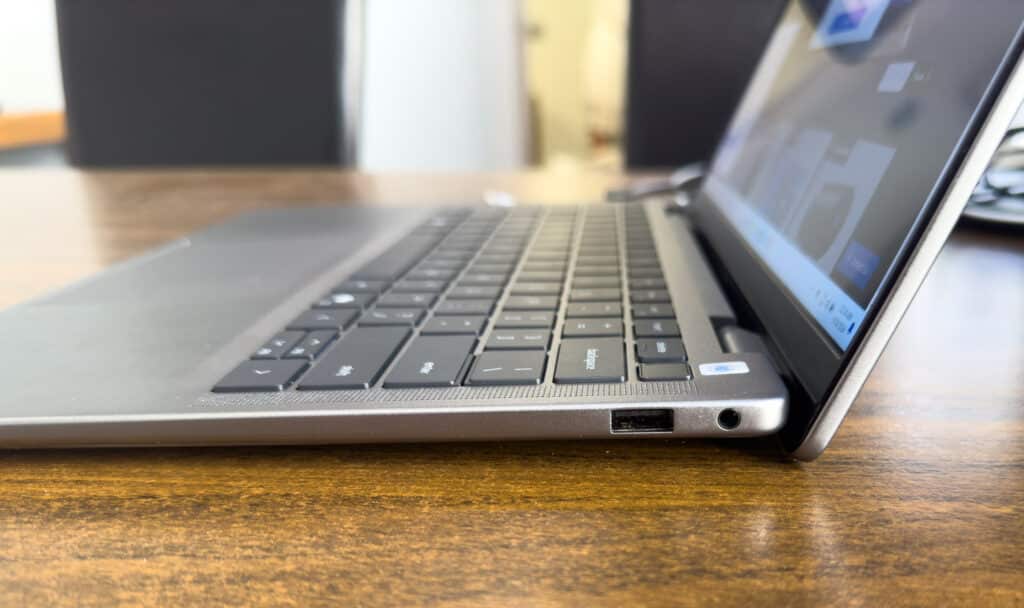
The Latitude 7455 has a 54Wh battery that helps you stay up and running for extended periods. With Dell’s ExpressCharge, the battery can be charged up to 80% in just an hour, so you spend less time plugged in and more time getting things done. While it’s hard to say how long the battery will last in every situation, the three-year life cycle and up to 1,000 charge cycles are solid numbers, making it eco-friendly and reliable without cutting corners on performance.
Dell’s commercial laptops, like the Latitude 7455, also come with a super handy 3-year Next Business Day On-Site repair service. This ensures that hardware issues are addressed quickly, minimizing downtime and keeping operations running smoothly. This support level provides peace of mind for professionals who can’t afford delays.
| Dell Latitude 7455 Specifications | |
| Processor | Qualcomm Snapdragon X Plus X1P-64-100 (10 cores, up to 3.4 GHz, 45 TOPS NPU) |
| Operating System | Windows 11 Pro (64-bit ARM) |
| Graphics | Integrated Qualcomm Adreno GPU |
| Memory | 16 GB LPDDR5x (8448 MT/s, onboard) |
| Storage | 512 GB M.2 2230 TLC PCIe Gen 4 NVMe SSD |
| Display | 14.0″ QHD+ (2560×1600) IPS, Anti-Glare, Touchscreen, ComfortView Plus, 400 nits |
| Ports |
|
| Keyboard | Backlit, 79-key, English (US), with dedicated Copilot key |
| Touchpad | Precision Clickpad with multi-touch gesture support |
| Camera |
|
| Audio |
|
| Wireless | Qualcomm FastConnect 7800 Wi-Fi 7, Bluetooth 5.4 |
| Battery | 3-cell 54 Wh, Li-ion, ExpressCharge (80% in 60 minutes) |
| Chassis | 50% Recycled and 50% Low-Carbon Aluminum (Titan Gray) |
| Dimensions |
|
| Weight | 3.17 lbs (1.44 kg) |
| Security |
|
| Power Adapter | 65W AC Adapter, USB Type-C, EcoDesign |
Design, Build, and Functionality
The Dell Latitude 7455 features a nice balance between premium aesthetics, durability, and portability. The Titan Gray exterior gives the laptop a sleek, professional look, while the lightweight and thin profile makes it easy to carry around. Weighing in at just 3.17 pounds and only 0.67 inches thick, this is one of the thinnest Latitude models, making it perfect for professionals who need to travel light or frequently switch between working environments.
The aluminum chassis is also designed to endure daily use while helping to keep the device cool. The build feels solid, with minimal flex in the keyboard deck or screen, ensuring long-term durability. The overall fit and finish are excellent, and the machine feels solidly built without being bulky, maintaining its premium feel.
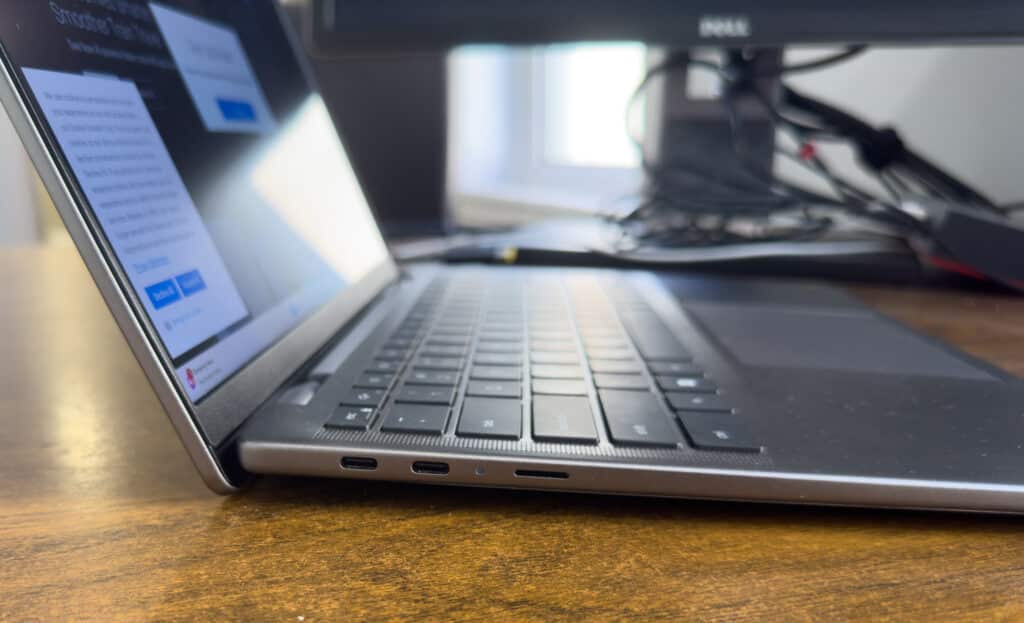
Despite being one of Dell’s thinnest offerings, it has a decent range of I/O ports, including two USB 4 Type-C ports with DisplayPort 2.1 and Power Delivery support. There’s also a USB 3.2 Gen 1 Type-A port for legacy connections, a microSD card reader, and a nanoSIM card slot for systems equipped with WWAN.
A universal audio jack is available for headphones or microphones, and there’s support for Bluetooth 5.4 and Qualcomm’s FastConnect 7800 for Wi-Fi 7.
The Latitude 7455, powered by the Snapdragon X Elite CPU, offers a blend of performance and portability that’s hard to overlook. The screen is the first eye-catching feature, boasting both matte and touch capabilities, giving users a sharp display that’s easy on the eyes in various lighting conditions. This versatility, combined with Dell’s signature build quality, provides a premium feel for those who need to stay productive on the go. The keyboard deserves special mention; its fantastic size, layout, and tactile response make for a seamless transition without any adaption curve, allowing users to type quickly and confidently.
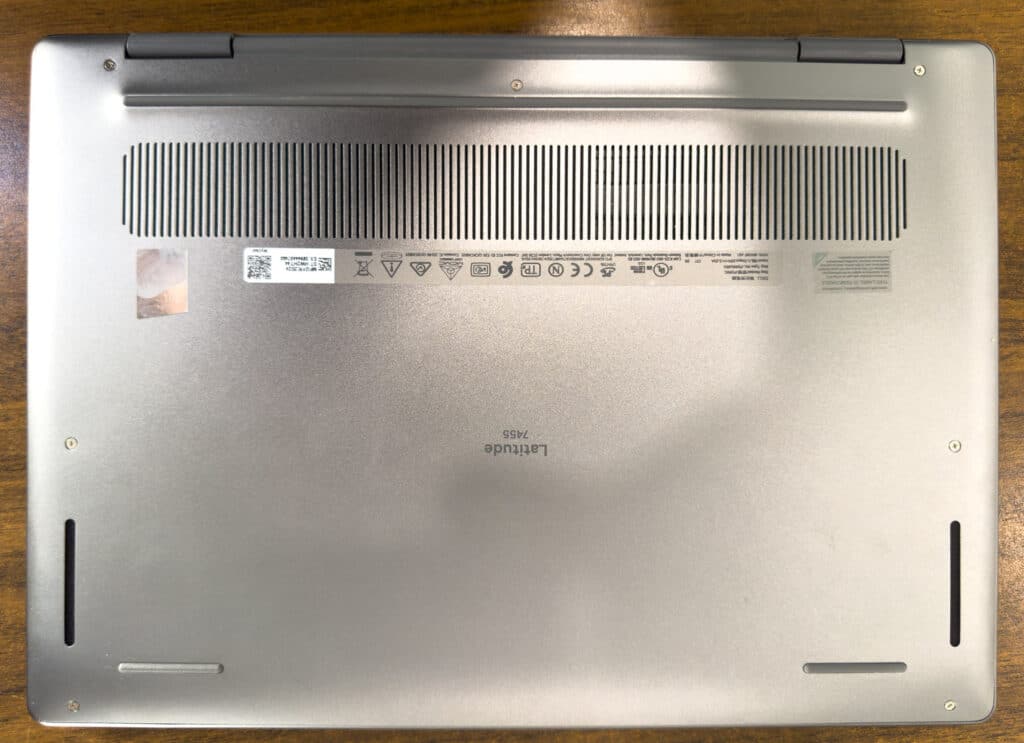
While the trackpad is somewhat underwhelming, it’s more than serviceable for quick tasks while out and about. That said, docking and connecting external peripherals and displays is easily handled, allowing smooth multitasking without hiccups. Perhaps one of the most impressive attributes of the Latitude 7455 is its weight—or lack thereof. It’s exceptionally light, especially considering its above-average build quality, though the materials are a bit soft and susceptible to scratches. Despite this, the system feels sturdy enough for everyday professional use.
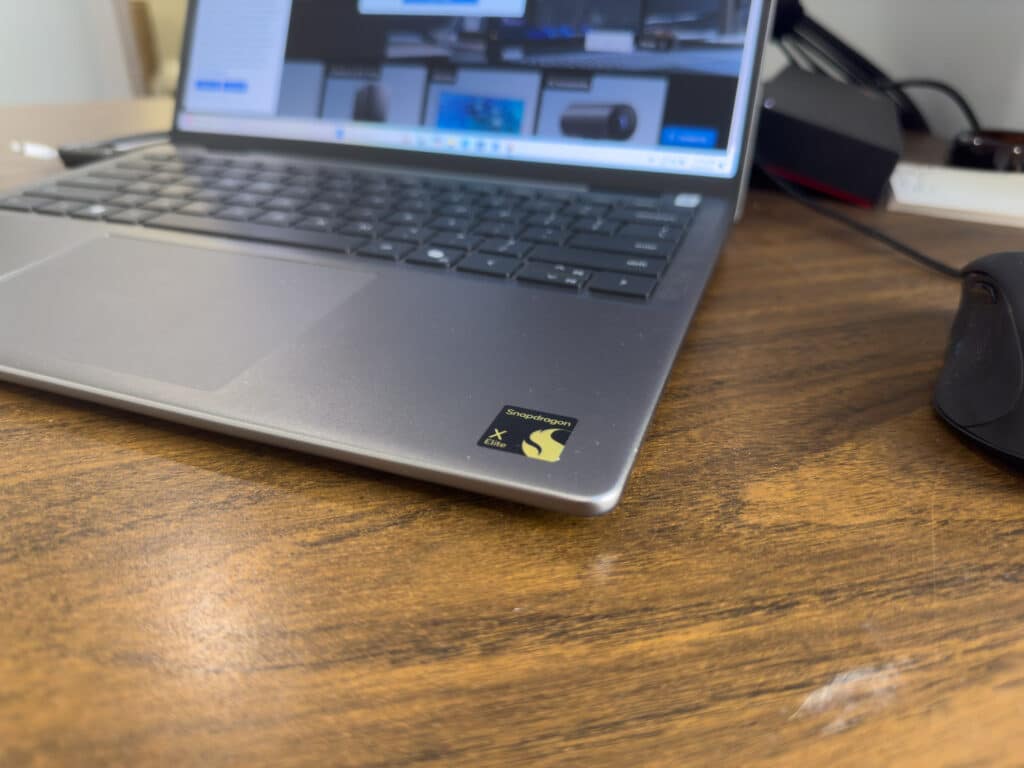
Dell has nailed the biometric features as well. Windows Hello facial recognition and the fingerprint sensor rank among the best in the industry, providing reliable and speedy authentication. Another slight drawback is the screen’s limited opening angle—while 180 degrees would have been ideal, it’s far from a deal-breaker since many laptops fall short in this area. Thermals, on the other hand, are practically non-existent, thanks to the efficiency of the Snapdragon X Elite. It runs so cool that heat management isn’t even part of the conversation.
Performance
For our review build, the Dell Latitude 7455 comes equipped with the following components:
- Processor: Snapdragon X Elite (12 cores, base clock up to 3.4 GHz, Dual-Core Boost up to 4.0 GHz, 45 TOPS NPU)
- Memory: 32GB DDR5x running at 8448MHz
- Storage: 1TB M.2 SSD
- Display: 14” QHD+ (2560×1600) IPS panel
- Battery: 54Wh capacity
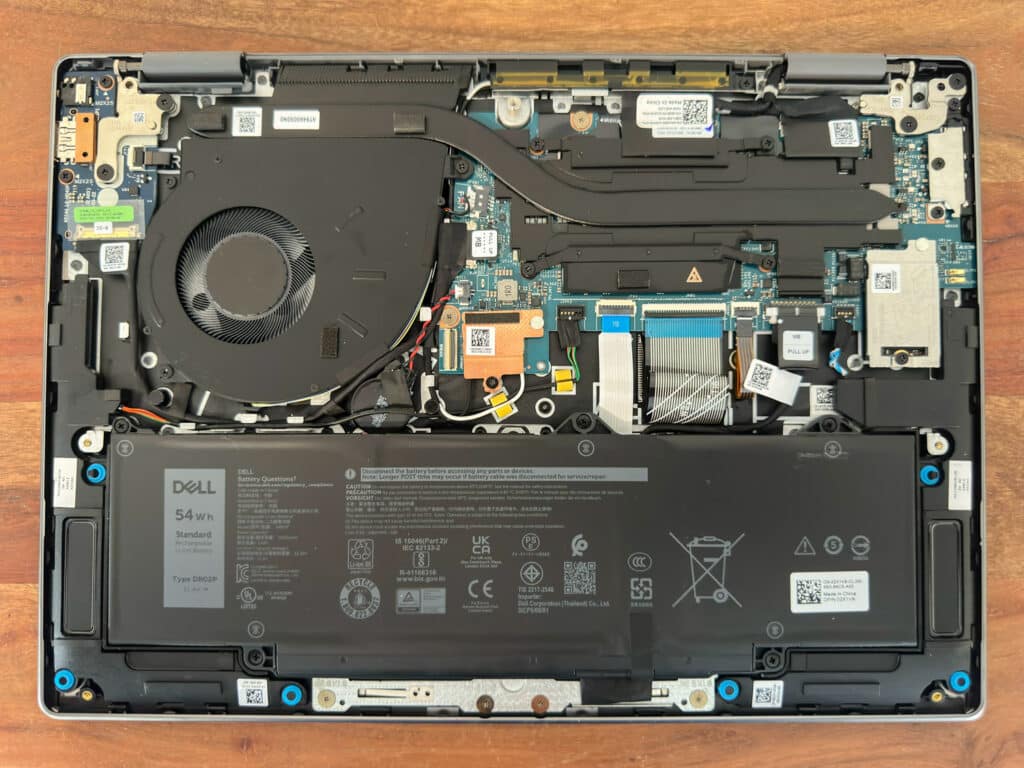
This configuration is priced at approximately $2,477. All performance tests and benchmarks were conducted with the Latitude 7455 in its Ultra Performance power mode, except for one portion of the Geekbench test, which we will detail separately.
We will be comparing it to the Dell Latitude 7450 Ultralight with the following specifications:
- Processor: Intel Core Ultra 7 165U CPU w/ Intel vPro
- GPU: Intel Graphics (integrated)
- Memory: 32GB RAM
- Storage: 512GB SSD
This configuration is priced at approximately $2,369.
Geekbench
Geekbench 6 is a cross-platform benchmark that measures overall system performance. The Geekbench Browser allows you to compare any system.
In addition to the “Ultra Performance” power mode, we are looking at the performance in “Dell Optimized” mode. The comparison highlights the consistent performance in single-core tasks across both settings. In contrast, multi-threaded performance sees a significant boost in Ultra Performance mode, emphasizing the CPU’s potential when pushed to its limits.
Here’s a more detailed breakdown.
- Single-Core Performance: There’s minimal variance between the two modes, with scores of 2411 in Dell Optimized and 2431 in Ultra Performance. This consistency suggests that single-core tasks, which often reflect general daily usage scenarios, are solid under typical operating conditions.
- Multi-Core Performance: A significant difference is observed here. In Dell Optimized mode, the score is 6140, but this jumps to 7076 in Ultra Performance mode. This increase highlights the advantage of utilizing the full power for heavy, multi-threaded tasks such as video editing, rendering, or complex calculations.
- OpenCL Scores: These scores measure the GPU’s computing performance and are similar across both modes, 20463 in Dell Optimized and slightly higher at 20545 in Ultra Performance.
| Dell Latitude 7455 | |||||||
| Test | Power Mode | Single-Core Score | Multi-Core Score | OpenCL Score | |||
| Geekbench 6.3.0 | Dell Optimized | 2,411 | 6,140 | 20,463 | |||
| Ultra Performance | 2,431 | 7,076 | 20,545 | ||||
| Dell Latitude 7450 Ultralight | |||||||
| Test | Single-Core Score | Multi-Core Score | GPU | ||||
| Geekbench 6.3.0 | 2,407 | 9,922 | 17,052 | ||||
y-cruncher
y-cruncher 0.8.3.9522 is a multi-threaded, scalable program that can compute Pi and other mathematical constants to trillions of digits. Since its launch in 2009, it has become a popular benchmarking and stress-testing application for overclockers and hardware enthusiasts. y-cruncher is running in the emulated mode for this test as it is not ARM native.
Here, the laptop computes 1 billion digits of Pi in just 245.544 seconds and scales up to compute 2.5 billion digits in 714.190 seconds.
| y-cruncher Total Computation Time (Lower is Better) | Dell Latitude 7455 | Dell Latitude 7450 Ultralight |
| 1 Billion | 245.544 seconds | 65.402 seconds |
| 2.5 Billion | 714.190 seconds | 208.399 seconds |
3DMark
3DMark is a popular benchmarking tool that evaluates the performance of a computer’s GPU and CPU with simulations that reflect both gaming and daily computing tasks. It offers a variety of tests tailored to different types of systems and workloads, providing a comprehensive overview of how well the hardware handles graphics-intensive and computational tasks.
For the Dell Latitude 7455, the results from the 3DMark benchmark tests give us a good look at its capabilities in handling both moderate and intense graphics workloads. The “Wild Life Extreme” test, which is designed to push the GPU to its limits with complex visuals and high-fidelity graphics, recorded a score of 6561 and frame rates around 39.29 FPS, suggesting that while it can handle graphically demanding tasks, it may not be optimal for high-end gaming or advanced rendering tasks. On the other hand, the “Wild Life” test, less intensive than the Extreme version, showed a remarkable score of 17347 with 103.88 FPS, indicating that the laptop is more than capable of managing everyday graphics needs efficiently. The “Night Raid” and “Time Spy” tests, which focus on graphics and CPU performance, further illustrate the laptop’s competence with scores of 27,004 and 1931, respectively, demonstrating good performance for mainstream gaming and general computing tasks.
Here’s a summary of the results:
| Benchmark Test | Score | Frame Rate (FPS) |
| Wild Life Extreme | 6,561 | 39.29 |
| Wild Life | 17,347 | 103.88 |
| Night Raid | 27,004 | N/A |
| Time Spy | 1,931 | N/A |
PCMark 10 Battery Test
This PCMark 10 benchmark specifically evaluates the battery life of devices under continuous video playback conditions, providing a real-world assessment of how long a laptop can handle video-based tasks on a single charge.
In the test, the Dell Latitude 7455 started with a battery level of 98.0%. It sustained video playback for an impressive 14 hours and 33 minutes, concluding the test with a battery level of 3.0%. This result is significant as it indicates the laptop’s ability to handle long stretches of media consumption or video-based work without needing a recharge, making it ideal for those who require a device that can last through long flights, extended meetings, or continuous multimedia usage. The extended battery life in such a demanding scenario certainly highlights its suitability for professionals constantly on the go and consumers who prioritize endurance in their computing devices.
In comparison, the Dell Latitude 7450 Ultralight recorded 12 hours and 10 minutes.
UL Procyon AI Inference
UL’s Procyon estimates a workstation’s performance for professional apps.
The UL Procyon AI Inference benchmark results show that the Dell Latitude 7455 can handle various AI-driven tasks, emphasizing its capability across different complexity levels in AI models. The test indicates extremely efficient processing times with MobileNet V3 at 0.30 ms and ResNet 50 at 0.70 ms, optimized for rapid image recognition tasks, making it suitable for mobile and image-based applications. It handles more complex models like Inception V4 and DeepLab V3 with times of 1.42 ms and 4.85 ms, respectively, indicating strong performance in detailed image analysis and segmentation tasks. YOLO V3 processes at 3.47 ms, showcasing proficiency in real-time object detection, crucial for applications needing immediate responses. However, the Real-ESRGAN, a model for image upscaling, takes longer at 91.41 ms, suggesting some limitations in highly demanding computational tasks. Overall, the Dell Latitude 7455’s performance suggests it is well-suited for a wide range of professional AI applications.
| UL Procyon Average Inference Times (Lower is better) | Dell Latitude 7455 | Dell Latitude 7450 Ultralight |
| MobileNet V3 | 0.30ms | 1.72ms |
| ResNet 50 | 0.70ms | 21.94ms |
| Inception V4 | 1.42ms | 63.74ms |
| DeepLab V3 | 4.85ms | 68.92ms |
| YOLO V3 | 3.47ms | 175.95ms |
| Real-ESRGAN | 91.41 ms | 6,518.99ms |
| Overall Score | 1,799 | 65 |
7Zip Compression Benchmark
The built-in memory benchmark in the 7-Zip utility measures the performance of a system’s CPU and memory during compression and decompression tasks, indicating how well the system can handle data-intensive operations. We run this test at a 128MB dictionary size when possible.
During the compressing phase, the laptop reaches a peak CPU usage of 1127%, with a performance rating of 96.041 GIPS and a slightly higher 96.191 GIPS upon completion, showcasing its efficiency in data compression. The CPU maintains this high usage level throughout the task, demonstrating the system’s ability to sustain performance under load.
In the decompressing phase, CPU usage increased to 1176%, reflecting an even more intensive demand on the system. Despite the increased load, the performance slightly decreases, with initial and resulting ratings of 90.805 GIPS and 91.214 GIPS, respectively. This change indicates solid handling of decompression tasks, although with a slight reduction in efficiency under maximum load.
The Dell Latitude 7455 shows great endurance and capability, maintaining a high total CPU usage of 1156% and a total rating of 93.703 GIPS.
| 7-Zip Compression Benchmark (Higher is better) | Dell Latitude 7455 | Dell Latitude 7450 Ultralight |
| Compressing | ||
| Current CPU Usage | 1127% | 589% |
| Current Rating/Usage | 8.523 GIPS | 6.887 GIPS |
| Current Rating | 96.041 GIPS | 40.590 GIPS |
| Resulting CPU Usage | 1127% | 579% |
| Resulting Rating/Usage | 8.533 GIPS | 7.301 GIPS |
| Resulting Rating | 96.191 GIPS | 41.454 GIPS |
| Decompressing | ||
| Current CPU Usage | 1176% | 1073% |
| Current Rating/Usage | 7.720 GIPS | 4.310 GIPS |
| Current Rating | 90.805 GIPS | 46.241 GIPS |
| Resulting CPU Usage | 1184% | 1122% |
| Resulting Rating/Usage | 7.704 GIPS | 4.480 GIPS |
| Resulting Rating | 91.214 GIPS | 50.290 GIPS |
| Total Rating | ||
| Total CPU Usage | 1156% | 851% |
| Total Rating/Usage | 8.119 GIPS | 5.891 GIPS |
| Total Rating | 93.703 GIPS | 45.872 GIPS |
Conclusion
This system uses a low-power SOC, and it’s not built for heavy-duty stuff like 3D modeling or video editing. The Snapdragon processor and GPU can handle lighter tasks like media consumption, data analysis, and basic content creation. The hardware is compelling; the Lattitude engineering comes through. And one day, the Dell Latitude 7455, or its successors, will be a good fit for those prioritizing efficiency and collaboration or anyone juggling a busy workload — once the Windows ARM experience matures.
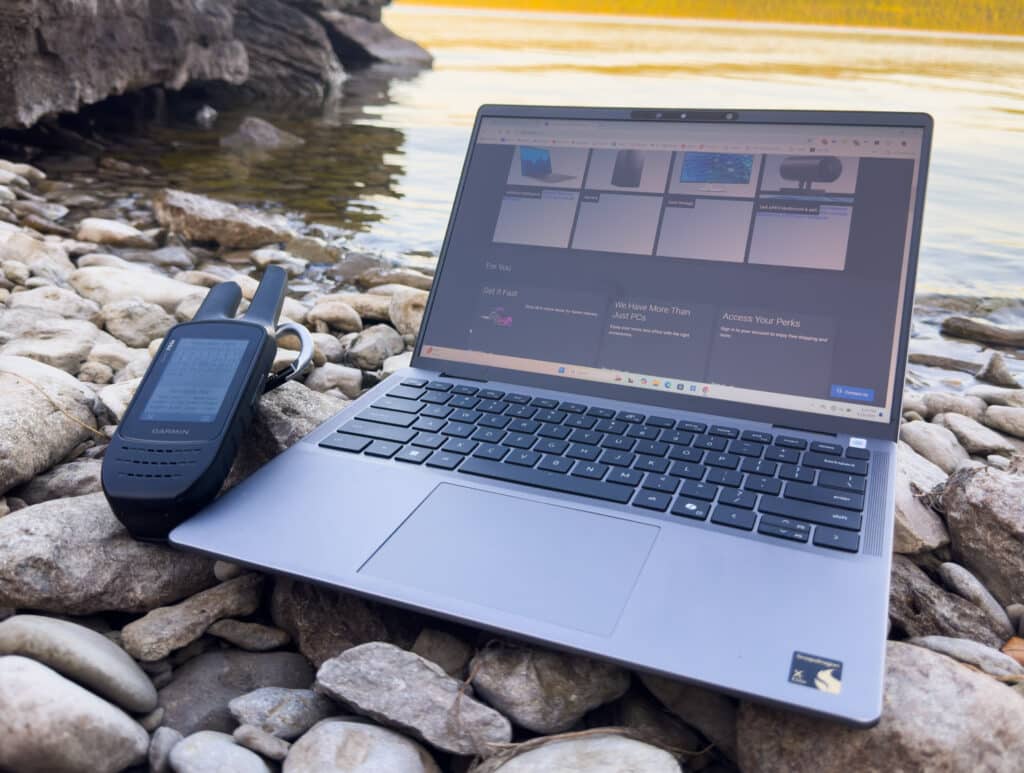
Over the last few weeks of testing, we have noticed improvements in the Windows ARM OS and firmware and driver refinements, so we’re optimistic about improvements. If the user workload is browser and Microsoft Office-based, with only occasional dips into the non-ARM Native ecosystem, this system will deliver well. But even in that base-case scenario, it’s hard to justify this hardware expense for users who stick exclusively to the ARM-friendly realm. Dell has many other better choices for those wanting a thin and light portable experience that costs much less.
It’s hard to fault Dell here. Specifically, they wanted to get on the Snapdragon train, and for a good reason: the integrated AI potential is impactful. But Microsoft needs to rapidly resolve what’s essentially a Beta OS at this point. We have faith, but this modern Windows/Snapdragon journey is going to require a lot of patience.




 Amazon
Amazon